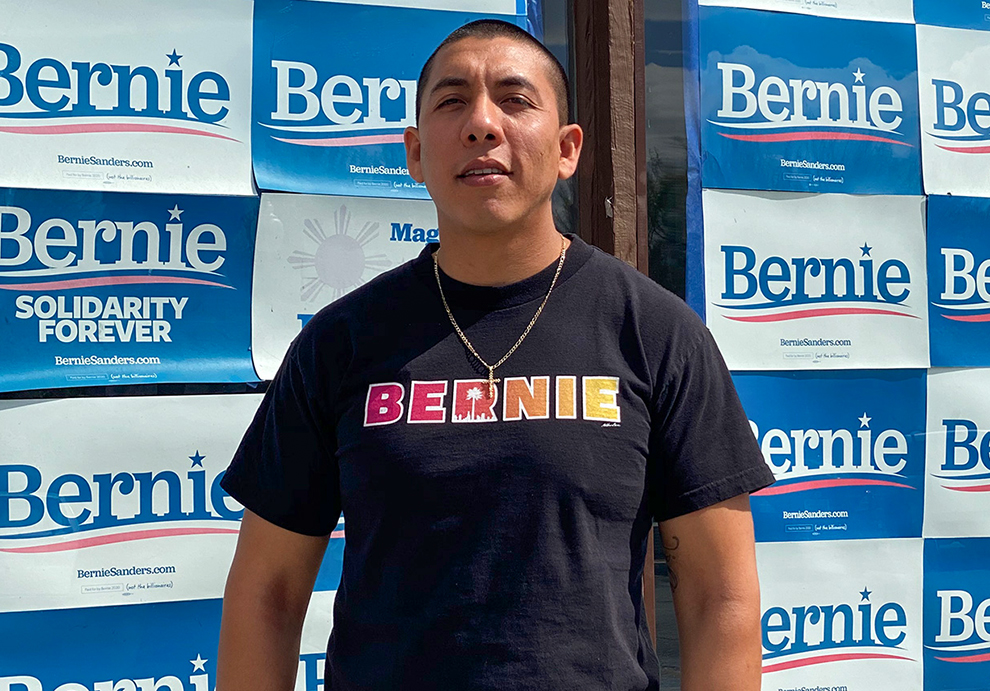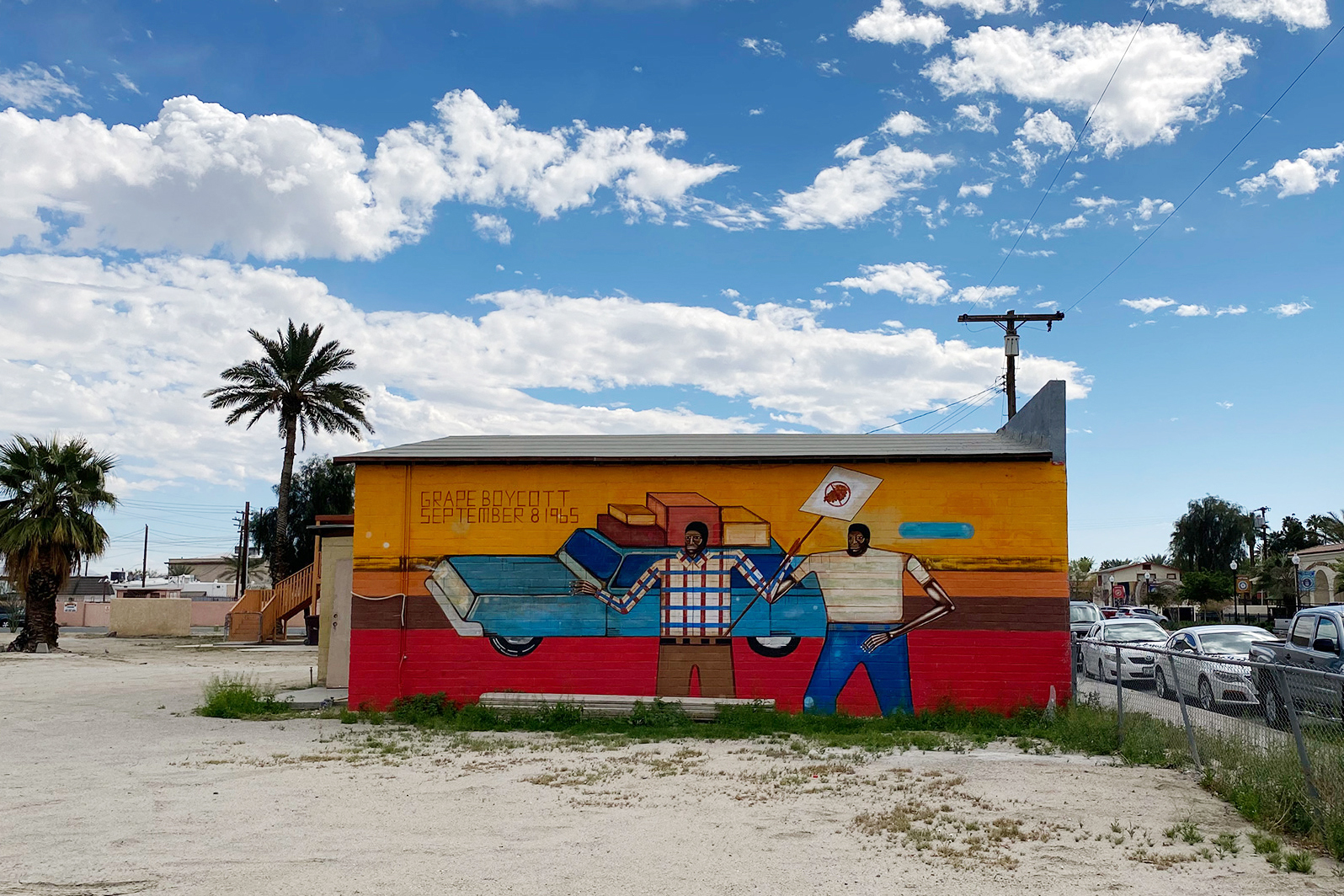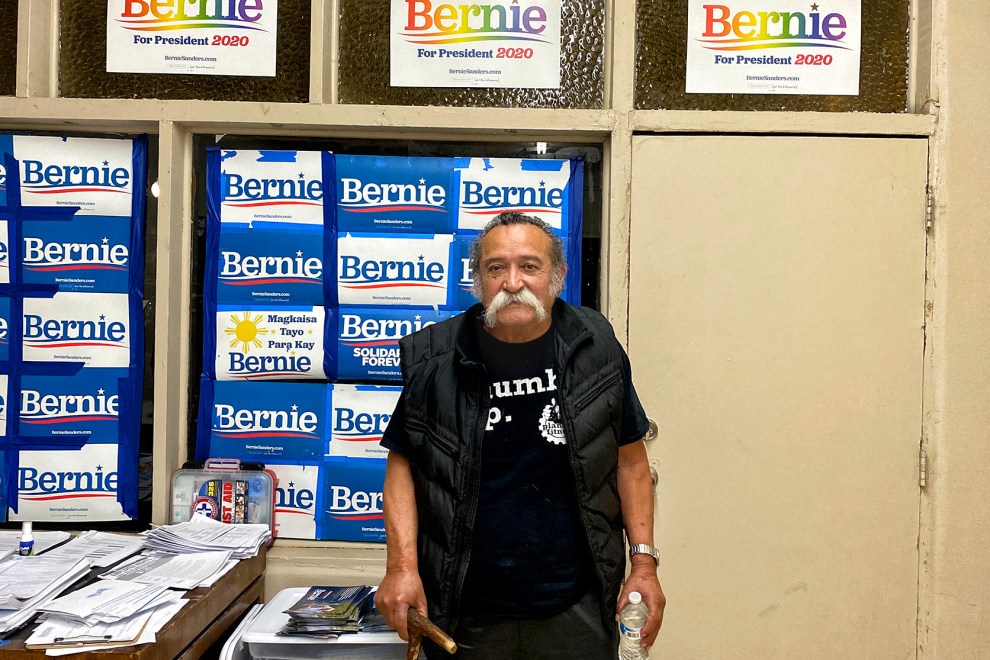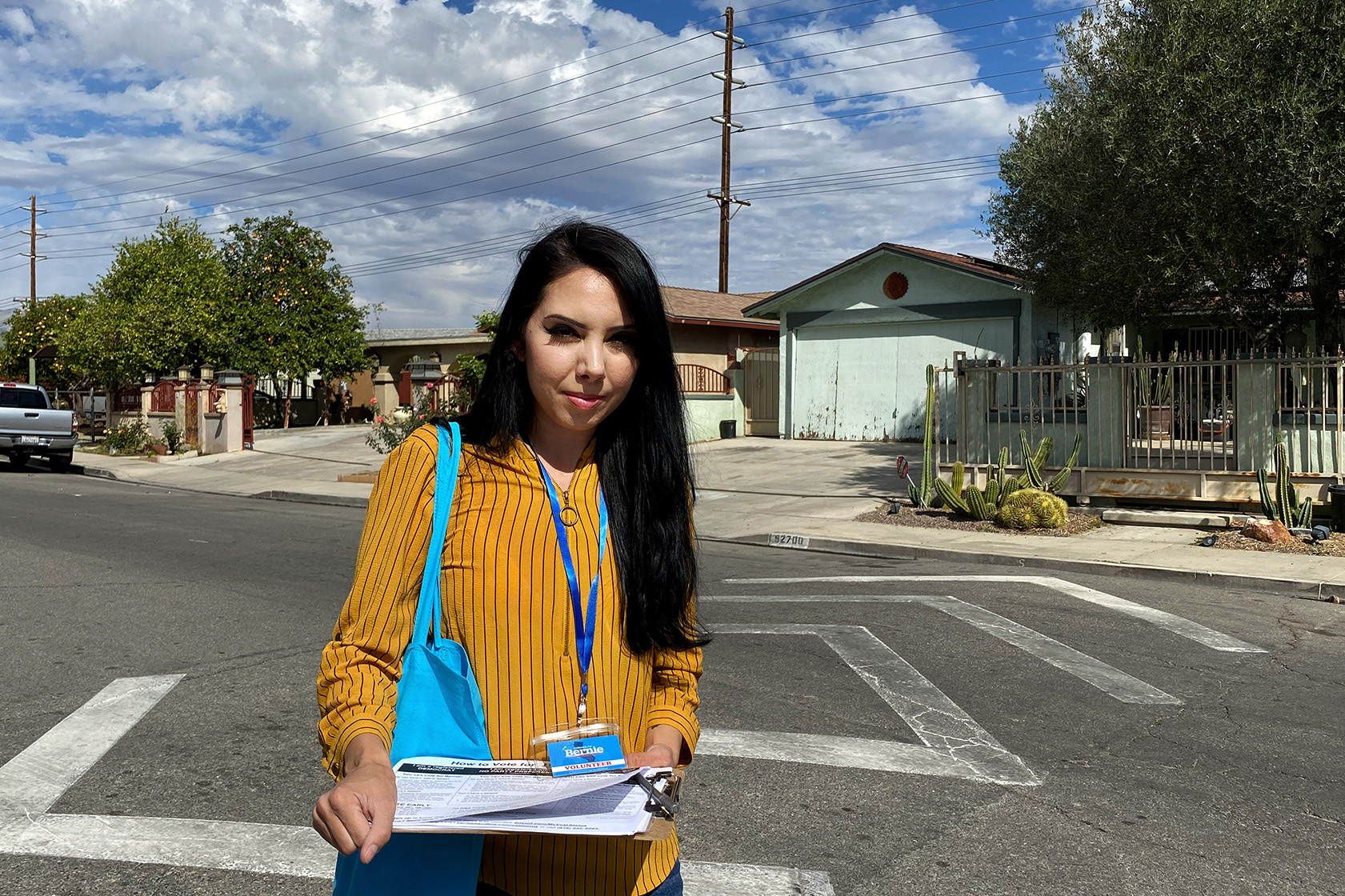When I first met Oscar Ortiz at his job in downtown Coachella, California, I noticed two things right off the bat. One, he’s very tall—like, 6-foot-enough to make it awkward for this 5-foot reporter to walk next to him and get a microphone anywhere near his mouth. And two, he’s got a pretty chill demeanor—at least until he mentions Bernie Sanders. That’s when his voice gets a little louder, his smile wider, and his hands join the conversation.
Ortiz, 30, is the field organizer for the Sanders campaign’s Coachella office, and when I arrived in town late last week, he was busy making calls. As we walked around the park across the street before more volunteers arrived for the 6 p.m. meetup, he told me about how he was born in the Mexican border city of Mexicali and how his family moved two hours north to the Coachella Valley when he was just a toddler. Like a lot of people his age, his mom cleaned houses and his dad worked in the fields. Growing up, Ortiz excelled in school—“I was a nerd who looked like a cholo,” he said—and eventually left the valley to get a chemistry degree at Stanford.
After graduating, he worked for a pharmaceutical company for a while, and then in the cannabis industry. But eventually he returned home to Indio, next door to Coachella, because he wanted to be involved in the community that raised him. He started attending city council meetings and in 2018 decided to run for a seat. His campaign was inspired by Sanders, he said: Even though he had only $8,000 in his war chest, he knocked on hundreds of doors and won the seat. Since then, he said, he’s focused on “changing the conversation around a lot of issues that were being ignored”—namely, immigration, affordable housing, and climate change.
Listen to MoJo’s Fernanda Echavarri going door-to-door with a band of young Latinx Bernie Sanders supporters in California, a state that gave the senator a fighting chance to stay in the presidential race, on this episode of the Mother Jones Podcast:
So when Ortiz heard that Sanders was opening up an office in Coachella, a city of about 45,000 people where almost 98 percent identify as Hispanic or Latino—the kind of place that presidential candidates typically ignore—he quickly contacted the campaign seeking a paid organizing position. He started working for Sanders’ campaign in December and was thrilled seeing people “put in so much effort to get Bernie as our representative in the White House…Just imagine, we could go from Trump to Bernie Sanders by grassroots organizing—it’s so exciting!”

Fernanda Echavarri/Mother Jones
Four years ago, when Sanders faced off against Hillary Clinton for the Democratic presidential nomination, there was no Oscar Ortiz running a campaign office in the 36th Congressional District, which encompasses Coachella, glitzy Palm Springs, and a slew of mostly working-class, mostly Latinx communities in the arid region of eastern Riverside County known as the East Valley. That’s because there was no office, and the nearest Sanders outpost was a communal Democratic Party workspace 20 miles away. Sanders performed worse in the 36th than in any other California district, winning just 37 percent of the vote to Clinton’s 62 percent. Clinton, of course, went on to win the California primary en route to sealing the nomination.
Sanders was criticized in 2016 for not directly appealing to people of color—for framing his candidacy around an economic determinism to which matters of culture tended to be subordinate. But his efforts among Latinx voters in California point up a shift in emphases from 2016 to 2020. There are a record 32 million eligible voters who identify as Hispanic—a group that skews younger and for the first time will make up the largest voting bloc of people of color in the country. At about 13 percent of the electorate, Latinx voters will slightly outnumber Black voters in 2020.
This cycle, the Sanders camp has prioritized Latinx voters and underserved communities in California with “a significantly larger operation” than it had in 2016, with 23 offices and more than 100 staffers, said Jon Jacobo, the campaign’s California Latino press secretary. Opening up field offices in places like Coachella means “that we see you, we hear you, and we’re here to work with you,” Jacobo added. “It’s easy to buy airtime and radio slots, but it’s another thing to intentionally invest resources into a community that is often overlooked.” And rather than simply hire a large consulting firm, the campaign tapped “talented leaders within the community,” who can better connect with the local activists and organizers.
The efforts have started to pay dividends: Across the country, Latinx leaders and organizations have thrown their support behind Sanders, from Rep. Alexandria Ocasio-Cortez to Mijente, which describes itself as “a national hub for Latinx and Chicanx organizing.” In Nevada, the first primary contest with a large Latinx electorate, entrance polls showed Sanders winning 53 percent of Latinx voters—more than three times as much as former vice president Joe Biden’s 17 percent.
And on a disastrous Super Tuesday during which Joe Biden swept the Southern primaries, it was in California that Sanders held the line, picking up nearly half of the Latinx vote, including 72 percent of Latinx voters under 30, according to initial exit polling. He won the state thanks in large part to the work being done by people like Oscar Ortiz in places like the Coachella Valley. Here, the ideas and ideals of Bernie-style democratic socialism found a natural home among the sons and daughters of the people who helped reconstitute the New Deal for an era of multicultural politics.

Located in the heart of the city, the Sanders campaign’s Coachella office is in the same building where civil rights legends Dolores Huerta and Cesar Chavez organized farmworkers in the 1960s. Colorful murals honoring the 1965 grape boycott adorn the facade of the one-story duplex known as Casa Del Trabajador (House of the Worker). On one side, blue and white “Bernie 2020” signs cover the windows. On the other side of the building, a small tax preparation office serves mostly farmworkers; when I went in to speak to the gentleman working there, he showed me the small stack of Bernie 2020 brochures at his desk.
While we walked around the park, Ortiz told me excitedly about Sanders’ visit to the area in December. “He actually came here to Coachella!” Ortiz said, noting that Sanders was the first presidential candidate since John F. Kennedy to visit the area. It was JFK’s “Viva Kennedy” campaign, in fact, that first attempted to forge out of many disparate communities a pan-ethnic “Latin American” voting bloc, as Benjamin Francis-Fallon documents in his 2019 book, The Rise of the Latino Vote. He calls the campaign “as close to the birth moment for ‘Latino politics’ as one can identify.”
Some 50 years later, the mayor and the city council stood alongside Sanders outside the campaign office while the candidate riffed on immigration reform and the Green New Deal to a crowd of about 500 fans.

Fernanda Echavarri/Mother Jones
Sanders’ presence—his office, his staffers, his visit—meant something to the people here. While most people outside of Southern California hear “Coachella” and think of the massive annual music festival or the Instagrammable Joshua Tree National Park, the area is home to families who have been in the area for generations and whose histories center around farmwork, immigration, and deep connections to Mexico.
“His ideas are spreading a lot faster, and they resonate so well with our communities,” Ortiz tells me. The Latinx voters I talked to said they’re supporting Sanders because he wants to get big money out of politics, address income inequality, reverse the Trump administration’s anti-immigrant policies, and prioritize the country’s response to climate change.
That last point is no small one, Ortiz emphasized: About 100 years’ worth of pesticides have drained into the nearby Salton Sea, and as the water evaporates, the toxic dust that’s left behind has caused a spike in asthma and cancer rates. And as housing costs in and around Coachella continue to rise, Ortiz said, more and more people are moving to the Salton Sea area, where housing is cheaper because of the health hazards.
“I think it’s easy to see that he’s focused on the same things that we’re focused on, right? So, we see affordable housing is a big issue out here, right? And that was one of the main points in our campaign, as well. And we see Bernie has this huge plan to make, like, 10 million affordable housing units throughout the country. And we see his focus on climate change, his focus on the minimum wage, his focus on income inequality. It just resonates so well with us here. The connection is so obvious for us.”
Edward Roybal saw as much in the 1970s, another era of federal retrenchment. The first Mexican American to sit on the Los Angeles City Council and the first Latino in the modern era to be elected to Congress, Roybal was a pioneer in Latinx politics. In 1976, testifying before the Democratic Platform Committee, he argued that Democrats “needed to develop policies with [Latinos’] specific needs in mind,” Francis-Fallon writes. Roybal’s vision of the “Latino community” was inseparable from the framework established by the New Deal of an aggressive federal commitment to securing economic justice for all Americans.
He spoke of the “certain core values which the Latino community holds deeply,” first of which was “a strong and vibrant FAMILY structure.” He argued that “economic security is the social cement which holds the family together.” Full employment, domestic economic development banks, and affirmative action too were essential to supporting the Latino family, as was good housing and “full comprehensive national health insurance.” It was “unemployment, underemployment, and job discrimination,” and not the state, that were “inherently anti-family,” Roybal declared.
Roybal beheld a party whose willingness to pursue economic justice was wavering during the difficult economic times of the 1970s and asked for “direct commitments” to support this agenda, steeped in fundamentally interlocking ideas of economic and cultural security.
It was the Bernie Sanders agenda, with a Latinx emphasis.
Friday evening at the campaign office, Ortiz and a few volunteers were packing up tote bags for the canvassers who were planning to go out. The next morning, I spoke with a couple of young men in their 20s who drove down from nearby cities in the valley—Desert Hot Springs and Cathedral City—to pick up their campaign materials. A few more volunteers stopped by, including Gina Chapa, who has been involved in local politics and organizing for years, especially after she saw the increase in Border Patrol’s presence in the community during the Trump administration.
Just as Ortiz was about to lock up for the night, Chapa brought over a neighborhood staple, 73-year-old Miguel Vargas, who lives just around the corner and is a big Sanders fan. He walked in using a worn wooden cane and eased into a chair at a folding table, eager to share stories from his past. Vargas talked about his life working in the fields for decades picking lettuce, cantaloupe, and celery, work that left him with several back injuries. “I didn’t go to school—I taught myself how to read and write,” he told us in Spanish, adding that his perspective wasn’t worthy of an interview. “But I’ve worked since I was a young boy and I’ve done my part.”

Fernanda Echavarri/Mother Jones
Vargas, whom Ortiz and Chapa would later describe as “a Coachella O.G.,” is drawn to Sanders because he sees him as “a man of the people,” far different from other candidates both past and present, he said. “From the beginning, this country has only belonged to a few families when it should belong to the people at the bottom who are working and are paying taxes,” he said. “The working people are hungry for justice.”
Vargas spoke passionately for almost an hour about how much he believed in Sanders and about his time working the fields in the days Cesar Chavez organized in the very same room we were in. We all listened quietly. Then, as he walked out of the office, he looked back at the volunteers and said he hoped more young people like them would follow in Sanders’ footsteps, even if he doesn’t become the next president of the United States. “Even if he doesn’t win,” Vargas said, “at least he’s opened people’s minds to new ideas.”

Shortly after noon the next day, young Latinas arrived one-by-one at the field office, ready to pick up their materials and go knock on some doors. It was striking: At one point I looked around the room, and all the volunteers were Latinas under 30 years old. Ortiz, wearing a black shirt with “Bernie” in colorful block letters, stood in the front of the room, giving them canvassing tips. He went over how to use the mapping app on their phones, and in the middle of his training a young man showed up wearing a shirt that read, in Spanish, “I ♥ Tío Bernie! He has my vote.”
Most of the seven volunteers had done work for the campaign in previous weeks. Before heading out, they were chatting about how often they talk to their older relatives about Bernie. One of the women said her mom already likes Sanders and calls him the “el viejito”—“the old man.” Another said some older relatives thought they should vote for Mike Bloomberg because all the commercials they saw on television were about the billionaire former mayor, so they assumed he was in the lead. Some joked about having to constantly step in and say, “No, mom, what you saw on Facebook or TV isn’t true. Let me explain.” Overall, I picked up that while there is support for Sanders from older voters, like Vargas, there’s work being done by younger Latinx to make the case at home.
I tagged along with one of the volunteers, Alva Perez, as she canvassed in a neighborhood not far from the campaign office. She told me she’s been a fan of the Vermont senator since his last campaign, but things were different back then—for starters, she said, Bernie supporters who volunteered to phone-bank at the closest Democratic office, in Cathedral City, had to share the space with Clinton supporters.

Fernanda Echavarri/Mother Jones
“Everyone there was over 50. Every time I was there, there were no young people, but it’s super different this time around,” Perez said. “I don’t know if reality set in or what, because I think last election there was a big bystander effect. Everyone thought, ‘Oh, someone else would vote and we’re already winning,’ but after the Trump turn, it’s been harsh. I think a lot of people have woken up and have gotten involved for that reason.”
Perez has a 4-year-old son and has been living in the valley since her family relocated from Northern California about a decade ago. She told me her mother aligns with her politically but not her father. Her parents often disagree, and her father thinks it’s “ridiculous” that she’s doing work for the Sanders campaign for free: “He’s a Trump supporter, he doesn’t speak English, and he was undocumented for the bigger part of my life, so it’s very confusing to me.”
With the sun shining on an 82-degree afternoon, Perez stopped by dozens of homes Saturday, trying to persuade residents to vote for Sanders. Some people were not home; some were out in their yards, working on their cars. One woman came out to her front yard and enthusiastically explained that she’d already voted by mail and that she and her husband had voted for Sanders. Other people who answered the door seemed unsure of whom they supported but were polite when Perez interrupted their Saturday afternoon. One man in his 40s said he voted Republican when he served in the military in the George W. Bush years, but that now, he would vote for “anyone but Trump”—and likely for Bernie.
Perez and I went back to the office so she could refill her tote bag with campaign materials and more water. Despite the heat, she went on to canvass more homes while I stayed behind to catch up with Ortiz. He was constantly on the phone helping out volunteers who had questions from the field and organizing a second group for Sunday. He was proud of the number of homes already reached by volunteers across the valley, especially in places that are more isolated and often forgotten. I drove back to Los Angeles and got a text from Ortiz the next day saying they had knocked on over 2,000 doors in the district over the weekend.

By 7 a.m. on Super Tuesday, Ortiz and his volunteers had checked on polling locations around the district to make sure they were open. As the day went on, Ortiz’s phone kept ringing and people came and went, trying to volunteer as much of their time as possible before the polls closed. Perez had to work that evening but still showed up early to help canvass for a few hours before her shift. She was frustrated to find people who still didn’t know it was primary day.
By nightfall, people had gathered at the campaign office for a little party—“nothing big, but we just wanted to show appreciation for the volunteers who were exhausted,” Ortiz told me over the phone Wednesday morning. They hired a taquero and played music while the news was on in the background. Ortiz was surprised and disappointed to see Sanders’ results in the rest of the country but was optimistic about what he’d seen out of California, where votes were still being counted and would be for some time: At the end of the day on Wednesday, Sanders and Biden were neck and neck in the 36th district, separated by some 400 votes.
Even though the primary had come and gone, Ortiz told me that his fellow volunteers were planning a “Bernie Journey” for a group of people to drive out to Arizona to canvass for the next round of primary elections on March 17. Despite the gains they’d made in Coachella, they still had a long way to go.
















